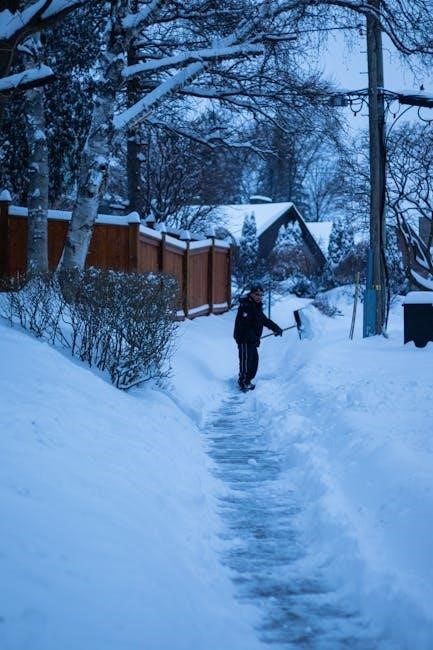This classic Twilight Zone teleplay by Rod Serling explores suburban hysteria sparked by a mysterious flash of light and power outages, revealing humanity’s darker side through fear and paranoia. The PDF version provides a detailed script, ideal for studying societal breakdown and human nature, offering timeless insights into Cold War-era anxieties and universal themes of suspicion and mob mentality.
Overview of the Teleplay
The teleplay The Monsters Are Due on Maple Street by Rod Serling depicts a serene suburban neighborhood disrupted by a mysterious flash of light and subsequent power outages. As residents gather to investigate, fear and paranoia escalate, leading to accusations and chaos. The story explores how ordinary people descend into hysteria when faced with the unknown, revealing darker aspects of human nature. The PDF version of the script provides a detailed account of the dialogue, stage directions, and narrative, offering insights into Serling’s critique of societal behavior and the destructive power of fear, making it a timeless commentary on human psychology.
Significance of the PDF Version
The PDF version of The Monsters Are Due on Maple Street is a valuable resource for readers, offering the complete teleplay script, stage directions, and narrative commentary. It allows for offline reading and analysis, making it ideal for educational purposes and personal study. The PDF preserves Rod Serling’s original dialogue and structure, providing a clear understanding of the story’s themes, character development, and dramatic progression. Additionally, it serves as a historical document, capturing the essence of a Twilight Zone episode that remains relevant in exploring human behavior, fear, and paranoia, ensuring its legacy endures for future generations.

Background of the Author: Rod Serling
Rod Serling, born on December 25, 1924, in Syracuse, New York, was a renowned American screenwriter, playwright, and narrator, best known for creating The Twilight Zone.
Rod Serling’s Contribution to The Twilight Zone
Rod Serling was the visionary creator, writer, and narrator of The Twilight Zone, crafting 92 episodes, including “The Monsters Are Due on Maple Street.” His unique narrative style blended science fiction with social commentary, addressing themes like fear, paranoia, and humanity. Serling’s ability to weave moral lessons into compelling stories made the series iconic. His work on “The Monsters Are Due on Maple Street” exemplifies his skill in using a suburban setting to explore hysteria and mob mentality, leaving a lasting impact on television and literature.
Themes Commonly Explored in Serling’s Work
Rod Serling’s work often delves into themes of fear, paranoia, and the darker aspects of human nature. In “The Monsters Are Due on Maple Street,” these themes are central, as neighbors turn on each other amid mysterious events. The PDF version of the teleplay highlights Serling’s ability to use science fiction as a lens for societal commentary, exploring how fear can unravel rational behavior and lead to chaos. His writing consistently examines the fragility of humanity and the dangers of unchecked suspicion.
Additionally, Serling’s stories often critique mob mentality and the breakdown of civilized behavior in crises. This is evident in the way the characters on Maple Street descend into hysteria, reflecting broader societal anxieties of his time. The timeless relevance of these themes ensures Serling’s work remains a powerful commentary on human behavior.

Plot Summary of “The Monsters Are Due on Maple Street”
A suburban neighborhood is disrupted by a mysterious flash of light and power outages, leading to escalating fear and paranoia among residents, ultimately revealing the true monsters;
Setting: The Suburban Neighborhood
The story unfolds on Maple Street, a quiet suburban neighborhood during a late September evening. The setting is peaceful, with residents enjoying the lingering warmth of an Indian summer. Lawns are being mowed, and people are engaged in routine activities, creating a sense of normalcy. The time is 6:44 p.m., and the neighborhood is bathed in the calm of a fading day. This ordinary setting contrasts sharply with the eerie events that follow, emphasizing the disruption of a tranquil community by mysterious forces, highlighting the fragility of suburban life and the onset of chaos.
Exposition: The Mysterious Flash of Light
The story begins with a mysterious flash of light streaking across the sky, disrupting the peaceful evening on Maple Street. This event triggers curiosity and fear among the residents, who gather to discuss the strange occurrence. The flash is followed by power outages, further heightening the sense of unease; As the community tries to make sense of these events, the flash of light becomes a catalyst for escalating paranoia and suspicion. This pivotal moment sets the stage for the breakdown of rational behavior, as the neighbors’ fears and anxieties begin to overshadow their initial calm and camaraderie.
Rising Action: Power Outages and Growing Fear
The mysterious flash of light is followed by power outages, intensifying the fear and confusion among the residents of Maple Street. As the lights flicker and fail, the neighborhood descends into chaos. The loss of electricity disrupts communication, heightening the sense of isolation. Paranoia spreads as neighbors begin to suspect one another of being “monsters” or alien invaders. The once-peaceful community becomes divided, with accusations flying and tensions rising. This escalating fear creates a volatile atmosphere, setting the stage for the breakdown of rational behavior and the emergence of mob mentality.
Climax: Paranoia and Accusations
As fear peaks, paranoia overtakes the neighbors, leading to frantic accusations. Suspicion escalates, with residents turning on one another, convinced that “monsters” are among them. The once-peaceful community collapses into chaos, with logic giving way to hysteria. Neighbors, now enemies, confront each other, fueled by irrational fears. The climax highlights the destructive power of unchecked paranoia, as mistrust and anger boil over, threatening to destroy the community from within. This pivotal moment underscores the fragility of human rationality in the face of uncertainty and fear.
Resolution: The True Monsters Revealed
The resolution shockingly reveals that the true monsters are not extraterrestrial beings but the neighbors themselves. Their fear and paranoia lead to their own destruction, highlighting the destructive power of hysteria and mistrust. The story concludes with the community in ruins, serving as a stark reminder of humanity’s susceptibility to fear and the dangers of unchecked paranoia.

Themes Explored in the Teleplay
Fear, suspicion, and paranoia drive the story, highlighting how hysteria can unravel a community. The teleplay critiques mob mentality and examines the darker aspects of human nature.
Fear and Suspicion in Society

The teleplay masterfully depicts how fear and suspicion can escalate into chaos in a seemingly peaceful society. A mysterious flash of light and subsequent power outages spark irrational fears among the residents of Maple Street. As the narrative unfolds, neighbors turn on each other, accusations fly, and trust disintegrates. The PDF version of the script highlights how fear of the unknown fuels societal breakdown, transforming ordinary people into aggressors. This theme remains timeless, reflecting Cold War-era anxieties while also resonating with modern fears of external threats and internal division.

The Danger of Paranoia
The teleplay vividly illustrates how paranoia can spiral out of control, destroying a once-peaceful community. The mysterious flash of light and power outages create an atmosphere of uncertainty, leading the residents of Maple Street to suspect one another of being alien invaders. As fear intensifies, rational thinking gives way to irrational accusations, and neighbors turn against each other. The PDF version of the script captures the escalating tension, showing how paranoia fosters mistrust and violence. Serling’s narrative serves as a cautionary tale about the destructive power of unchecked fear and the blurred line between reality and illusion.
Mob Mentality and Group Behavior
The PDF version of The Monsters Are Due on Maple Street highlights how mob mentality rapidly consumes the residents, transforming them from concerned citizens into a volatile crowd. As fear spreads, individual reasoning is overtaken by collective hysteria, leading to irrational decisions and violent actions. The teleplay demonstrates how group behavior, driven by fear and uncertainty, escalates tensions and erodes moral judgment. Serling’s portrayal of this phenomenon serves as a stark reminder of how quickly societal norms can collapse under pressure, revealing the darker aspects of human nature when individuals prioritize conformity over logic.
The Nature of Humanity
The PDF version of The Monsters Are Due on Maple Street delves into the primal aspects of human behavior, exposing how fear and stress strip away the facade of civility. The teleplay reveals that, beneath the surface of suburban tranquility, lies a raw, instinctual response to uncertainty. As the characters descend into chaos, their true selves emerge, showcasing humanity’s capacity for both unity and destruction. This exploration of human nature serves as a timeless critique, highlighting how easily societal norms can crumble under pressure, leaving individuals vulnerable to their basest impulses and primal fears.

Character Analysis
The teleplay features Steve Brand, the voice of reason, Don Martin, the skeptic, Charlie Farnsworth, the troubled youth, and Tommy and Sally, the innocent observers, highlighting diverse human reactions to fear and paranoia.
Steve Brand: The Voice of Reason
Steve Brand, a former Marine, emerges as the calm and rational leader in the chaos. His level-headedness contrasts with the growing hysteria, as he tries to maintain order and logic. However, even Steve’s resolve is tested, showing the fragility of reason under immense fear. His character serves as a beacon of hope but ultimately succumbs to the collective paranoia, illustrating the ease with which societal cohesion can crumble.
Don Martin: The Skeptic

Don Martin is the neighborhood skeptic, questioning the supernatural explanations for the strange occurrences. His rational mindset initially provides a counterbalance to the rising fear, challenging the group’s panic. However, as tensions escalate, Don’s skepticism fades, and he becomes increasingly paranoid, accusing others of being monsters. His transformation highlights how skepticism can crumble under pressure, leading even the most doubtful individuals to succumb to hysteria and paranoia, underscoring the teleplay’s themes of fear and societal breakdown.
Charlie Farnsworth: The Troubled Youth
Charlie Farnsworth, the troubled teenager, plays a pivotal role in spreading fear and paranoia on Maple Street. His initial calm demeanor shifts dramatically as he becomes convinced of an alien invasion, fueled by his earlier knowledge of science fiction stories. Charlie’s accusations escalate tensions, turning neighbors against each other. His character serves as a catalyst for the chaos, illustrating how youthful imagination and anxiety can spiral into hysteria. Charlie’s breakdown reflects the fragility of human psychology under stress, making him a tragic figure in the unfolding drama.
Tommy and Sally: The Innocent Observers
Tommy and Sally, the young residents of Maple Street, serve as innocent observers to the unfolding chaos. Their initial curiosity and calm demeanor starkly contrast with the growing hysteria. Tommy’s knowledge of science fiction stories inadvertently fuels the paranoia, as he suggests the possibility of alien invasion. Sally, his mother, tries to maintain rationality, but the escalating fear eventually engulfs her too. Their characters symbolize the loss of innocence and the rapid breakdown of normalcy in the face of the unknown. Their story highlights how fear can consume even the most well-intentioned individuals, reflecting the destructive power of unchecked anxiety.
Symbolism and Literary Devices
The flash of light and power outages symbolize the breakdown of rationality, while shadows and darkness represent fear and paranoia, contrasting with the lost normalcy of Maple Street.
The Use of Lighting and Shadows
The teleplay masterfully employs lighting and shadows to create tension and reflect the characters’ emotional states. The initial calm of Maple Street is depicted in warm, natural light, contrasting with the eerie darkness that follows the power outages. Shadows grow longer and more ominous, symbolizing the spreading fear and paranoia. Close-ups and low-angle shots amplify suspense, while dimly lit scenes emphasize the unknown, visually mirroring the characters’ descent into chaos. This interplay of light and shadow underscores the breakdown of rationality and the rise of hysteria, making the audience feel the escalating dread.
The Symbolism of the Flash of Light
The mysterious flash of light in “The Monsters Are Due on Maple Street” symbolizes the unknown and the catalyst for chaos. It disrupts the neighborhood’s tranquility, sparking fear and paranoia. The flash itself remains unexplained, leaving residents to fill the void with suspicion and dread. This enigmatic event represents the fragile balance between order and hysteria, highlighting how quickly rationality crumbles when faced with the unexplained. The flash serves as a harbinger of the breakdown of trust and civility, ultimately revealing that the true horror lies not in the light, but in the neighbors’ own darker impulses.
Camera Angles and Their Impact
The strategic use of camera angles in “The Monsters Are Due on Maple Street” heightens tension and emphasizes the growing paranoia. Close-ups capture the fear and suspicion in characters’ faces, while wide shots convey the chaos spreading across the neighborhood. Low-angle shots create a sense of unease, suggesting an ominous presence. The camera work subtly manipulates the audience’s perception, drawing attention to key moments of conflict and emotional breakdown. These visual techniques amplify the psychological drama, making the descent into hysteria feel both intimate and overwhelming, and underscore the themes of fear and societal collapse. The angles are a masterclass in visual storytelling.

Availability of the PDF Version
The PDF version of “The Monsters Are Due on Maple Street” is freely available for download from various online sources, ideal for offline reading and study.
Where to Download the PDF
The PDF version of The Monsters Are Due on Maple Street can be downloaded from various online platforms, including Scribd, Google Drive, and the Internet Archive. Websites like PDF Drive and other digital libraries also host this teleplay for free access. Additionally, educational platforms and repositories dedicated to The Twilight Zone scripts often provide direct download links. Users can search for “The Monsters Are Due on Maple Street PDF” to find reliable sources. Ensure to verify the authenticity of the document before downloading to avoid unauthorized versions.
Benefits of Reading the PDF
Reading the PDF of The Monsters Are Due on Maple Street offers a deeper understanding of Rod Serling’s masterful storytelling. The script provides insight into the structure of a teleplay, including stage directions and dialogue, which are invaluable for writers and students. The PDF format allows for easy highlighting and note-taking, enhancing analysis. Additionally, the story’s themes of fear, paranoia, and human nature remain relevant, making it a powerful tool for classroom discussions and personal reflection. It also serves as a historical lens into Cold War anxieties, offering timeless lessons on societal behavior and individual psychology.
Script Analysis
The PDF reveals Serling’s masterful use of dialogue and stage directions, offering insights into the teleplay’s structure and themes, while enhancing understanding of his storytelling approach.
Dialogue and Character Development
The PDF version of The Monsters Are Due on Maple Street highlights Rod Serling’s masterful use of dialogue to reveal character traits and escalate tension. Conversations between neighbors like Steve Brand and Don Martin expose their personalities, fears, and biases, driving the plot’s descent into chaos. The dialogue mirrors societal anxieties of the Cold War era, with accusations and paranoia reflecting deeper human frailties. Serling’s script also uses dialogue to contrast reason and hysteria, emphasizing the breakdown of rationality. This makes the PDF a valuable resource for analyzing how dialogue shapes character development and thematic depth in the teleplay.
Stage Directions and Their Importance
The PDF version of The Monsters Are Due on Maple Street includes detailed stage directions that enhance the teleplay’s tension and atmosphere. Camera angles, such as close-ups and long shots, are specified to emphasize fear and paranoia. Directions like “the camera takes us across the porches again” create a sense of voyeurism, immersing viewers in the unfolding chaos. Specific movements, like panning across the neighborhood, build suspense and highlight key moments, such as the mysterious flash of light. These directions are essential for translating Serling’s vision into a visual narrative, guiding actors and filmmakers to capture the story’s emotional depth and thematic complexity.

Educational Value of the Teleplay
The PDF version of The Monsters Are Due on Maple Street is a valuable educational tool, fostering classroom discussions on human behavior, fear, and societal hysteria, while encouraging critical thinking about timeless themes.
Using the PDF in Classroom Discussions
The Monsters Are Due on Maple Street PDF is an excellent resource for educators, offering a detailed script and stage directions that facilitate meaningful classroom discussions. Teachers can assign roles from the teleplay, encouraging students to analyze character motivations and dialogue. The document also provides a conflict map, helping students identify and explore the story’s central tensions. Discussions can focus on themes like fear, paranoia, and mob mentality, prompting reflections on human behavior. Additionally, the PDF’s structure allows for lessons on dramatic storytelling, making it a versatile tool for literature and drama classes.
Lessons on Human Behavior
The teleplay serves as a mirror to society, illustrating how fear and uncertainty can escalate into paranoia and mob mentality. It teaches how quickly rational individuals can turn on one another when faced with the unknown, highlighting the fragility of human behavior under stress. The story underscores the dangers of jumping to conclusions and the importance of maintaining reason in the face of chaos. These lessons remain timeless, offering insights into the darker aspects of human nature and the consequences of unchecked fear, making the PDF a valuable resource for understanding societal dynamics and individual psychology.
The Monsters Are Due on Maple Street PDF remains a timeless cautionary tale, highlighting human frailty and societal anxieties, ensuring its relevance in understanding fear’s destructive power.
Final Thoughts on the Teleplay
The Monsters Are Due on Maple Street is a gripping exploration of human nature, masterfully crafted by Rod Serling. The teleplay’s ability to weave suspense with social commentary makes it a timeless classic. Its portrayal of a community descending into chaos due to fear and paranoia serves as a stark reminder of humanity’s vulnerabilities. The PDF version captures the essence of the story, offering readers a vivid journey into the heart of suburban hysteria. It remains a powerful tool for understanding how quickly societal norms can crumble, making it a must-read for anyone interested in psychological drama and Cold War-era anxieties.
Relevance in Modern Society
The Monsters Are Due on Maple Street remains strikingly relevant today, as its themes of fear, paranoia, and mob mentality continue to resonate. In an era dominated by social media, misinformation, and political polarization, the teleplay’s depiction of a community unraveling under suspicion feels eerily familiar. The PDF version serves as a timeless cautionary tale, urging readers to reflect on how quickly fear can escalate into chaos. Its exploration of human frailty and the dangers of unchecked anxiety makes it a vital resource for understanding modern societal challenges and the importance of maintaining rationality in uncertain times.
